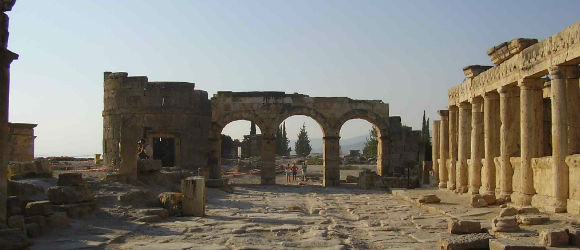The presence of a hot spring at Hierapolis and the spectacular calcium deposits from its water spilling over the nearby hillside suggest that there should be evidence of an early settlement there. The oldest Inscription found so far, however, indicates it was founded by Eumenes II, king of Pergamon, in the latter part of the second century B.C.; it soon became a busy industrial center.
Pagan worship in the city centered around Cybele, Apollo, Artemis, Men, Poseidon, and Pluto. Underneath the Temple of Apollo has been found the Plutonium, an opening in the earth from which a noxious gas still comes. The temple is between the pool where the hot spring rises and the large theater on the side of the hill. To the north along the rim of the plateau is a long avenue of tombs.
Traditionally St. Philip is connected with the early church in Hierapolis. Fairly recently Italian archeologlsts have discovered his Martyrium, an octagonal chamber forming a double cross surrounded by a square. This is almost due north of the theater, also on the side of the hill. It was a fifth century A.D. building and did not last much more than 100 years. No tomb was found with it although that was expected. There are several ruins of churches, one not far from the baths, one on the main road leading to the necropolis.
Hierapolis is listed in the New Testament along with Laodicea as the center of Epaphras’s work (Colos-sians 4:13). This was at the time Paul was writing to strengthen the message Epaphras was preaching and to condemn the “people who go in for self-mortification and angel-worship” (Colossians 2:18). Another less well-known resident of Hierapolis was Papias, a disciple of St. John and the author of the lost book called the Sayings of Jesus.
While Epaphras was is that area, a young slave was growing up in Hierapolis, a boy whose original name is unknown but whom we call by the Greek for “Acquired”, Epictetus. In his Discourses Epictetus often talks about the perfect missionary whose bed was the ground, whose only house the earth and sky and a shabby cloak, and who must love those who misuse him in the service of God. One wonders what the influence of those early Christians, many of whom were slaves themselves, was on this Stoic philosopher.
Hierapolis,


We had heard plenty about Pamukkale during our 2 years of living in Istanbul – both good and bad. We had been told it was a must see, do-not-miss attraction and we had also been warned that most of the postcard shots of the location are taken from a specific vantage point and that it wasn't quite as impressive as…
The cotton castle at Pamukkale made our trip to Turkey an unforgettable one..one has to walk the entire stretch to see the real beauty of this white cotton castle. Wear shorts or a swim suit when you go there …can get very hot.
We did the trip in 2005 we stayed overnight and Pamukkale looks like a giant mountain in the distance. The water is lovely and warm to walk through and it is amazing. Also the archaeology is very good outside the Pamukkale (Hierapolis)
Climb among the ancient ruins & imagine a bygone era.
It's worth a trip out to Pamukkale — the pictures do not do the place justice. The white calcium step formations with water flowing over them are beautiful and like nothing else in the world. They look like melting ice, except the water is hot! Hierapolis is a great place to look at them from, plus it is an interesting…
Pamukkale and Hierapolis ancient city are definitely worth visiting!
Pamukkale white travertines filled with thermal water are really beautiful!You have to take off your shoes to walk in the travertine area admiring splendid landscape and making wonderful photos!
Hierapolis is a wonderful open-air museum.In ancient times Hierapolis was a health center and many people came to this place to its…
we rented a car and drove from Oludeniz to Pammukale and back in a day. The time we spent at Pamukkale and Hierapolis was well worth it and highly recommended.
If you have a full day it is best to visit Hierapolis starting at the Necropolis, north entrance, and walking down the Roman road to the pools, theatre, baths, museum and terraces to Pamukkale below.
We visited in late October and again in November when the weather was still quite warm.There was a small mini bus with 15 tourists at…
the calcium terraces are a wonder,the ruins are great and the time we were there- we saw fresh excavations going on……..beautiful. the pool is crowded, restaurents do not have options if you are travelling with kids.the souvenir shops a little too expensive.
These are not on the scale of Ephesus, but still worth seeing.